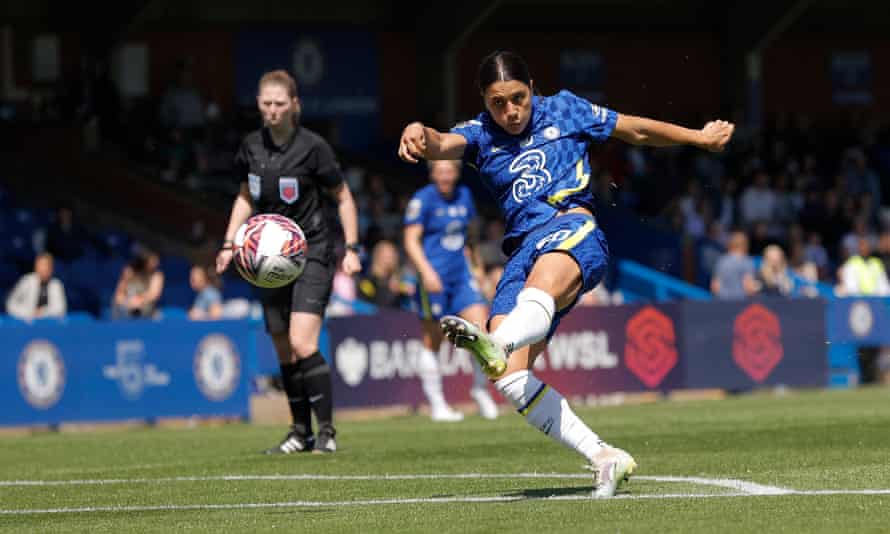Aabout four years ago, as the 2017-18 Ashes reached Perth, someone organized a game of football between the traveling English media and their West Australian counterparts. We assembled on some nondescript piece of suburban scrubland, the standard was extremely mixed and after Michael Vaughan slotted home the winning penalty we all retired to the bar for the most important business of the day.
As we sat there with our schooners, a local women’s team was heading out to train on the pitch we had just vacated. One of them was incredible. She had feet like hands. She had a head like a foot. She had a shot like the lash of a velociraptor’s tail. Clearly, I extrapolated, this woman was destined for bigger things. Bigger stages. Someone needed to discover her, find her an agent, get her a trial and a boot deal. I hastily made inquiries behind the bar.
“That’s Sam Kerr, mate,” the barman said, carefully siphoning off another jar of frothy water. “Ella She ella ‘s the best player in the world.” Something about this felt incongruous, strange, vaguely wrong on some level. How is it that the world’s greatest footballer has to share a pitch with a bunch of middle-aged cricket journalists? How is it right that Sam Kerr (Australia international, NWSL golden boot winner) has to use the same patch of grass as Jonathan Liew (falls over when trying to use left foot)?
And most pressingly of all, we were in the presence of greatness. Why weren’t we clambering over each other to watch it? I thought about that scorching afternoon in Perth while watching Kerr fire Chelsea to the Women’s Super League title on a scintillating final day of the season. In a way, everything about her from her – the adhesive touch, the movement, the sweet strike of the ball – was the same. And yet everything around her – the stage, the stakes, the crowd of more than 4,000 and the burning glare of a global television audience – was different.
The second goal. Can we talk about the second goal? Mary Earps, the Manchester United goalkeeper, makes a long clearance. Guro Reiten heads it back towards the D. Kerr controls the ball on her chest, spins on the spot and sends an unstoppable dipping volley over Earps and into the net. Thanks for coming, everyone.
But actually, the goal is even better when you watch it back. Because while Reiten’s header is looping towards her, Kerr glances over her shoulder to check Earps’s position on her. Or, put another way: Kerr manages to spin and volley the ball in from 25 yards, and she hasn’t even been looking at it the whole time. Can you conceive the difficulty level of that? She didn’t think. She just knew.
Then again, this has been one of the defining themes of Kerr’s career. Afterwards, she revealed she had predicted the goal in advance to her teammates, visualized it, trained for it. And what really marks Kerr out is not so much her talent but her conviction, the utter certainty – in the face of overwhelming historical and cultural odds – that she would be where she is today.

Sign up for our new and free women’s football newsletter!
For most of our lives, the inevitability of footballing talent was almost invariably been a male privilege. “He was always destined to be a star,” you read in soft-focus features about male players: the unspoken assumption that once natural gift meets hard work it will find its platform, that the justice of the marketplace will reward them appropriately. But with a few isolated exceptions – athletics, perhaps tennis – no such assumption has ever existed in women’s sport. The rewards have been too meagre, the opportunities too scarce, the prejudice too strong.
Throughout history there will have been female athletes of abundant talent whose names we will never know and who never earned a penny for their efforts. Boys knew that if they were good enough, they’d make it. Girls knew that good enough might still never be enough.

Blessed with sporting genes and an unwavering belief in her own ability, Kerr always seemed to have more of an inkling than most. And yet it was n’t until she first played for Australia at the age of 15 that she realized football could be her living from her. She questioned and doubted herself, even considered walking away from the sport. She arrived in London just a few weeks before the world shut down, leaving her adrift, alone and far from home. And so it is only really in the past year that we have seen Kerr at her most expressive of her: a warm, engaging presence off the pitch and a frightening, unstoppable presence on it.
Even four years ago on that little pitch in Perth, there was no real precedent for what Kerr has now become: a genuine global star, an Australian icon, the face of the next World Cup. It was a reality she had to dream up and create for herself: built on her own hard graft and the graft of those who went before her. With a little luck, the next Sam Kerr will have a slightly easier time of it.
A few months ago, during a Champions League game against Juventus, a man invaded the pitch at Kingsmeadow, interrupted the game and demanded a selfie with the Chelsea players. Nobody really knew what to do or how to react. Except Kerr, who took a run at the intruder and barged him to the ground. In more ways than one, it was a devastatingly powerful act. This is our pitch, she seemed to be saying. And we’re done sharing it.
Join Jonathan Liew on 24 May as he leads a panel with Andy ColeHope Powell and more to discuss the role Black British footballers have played both on and off the pitch. Book a ticket here.